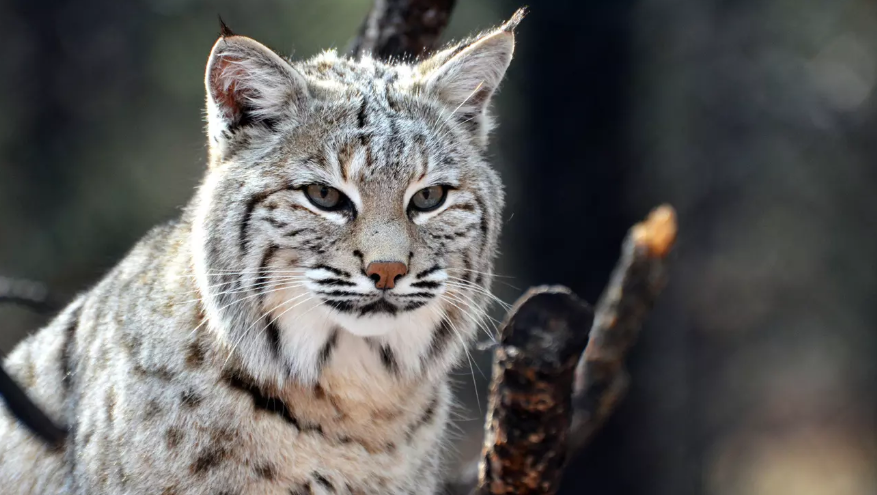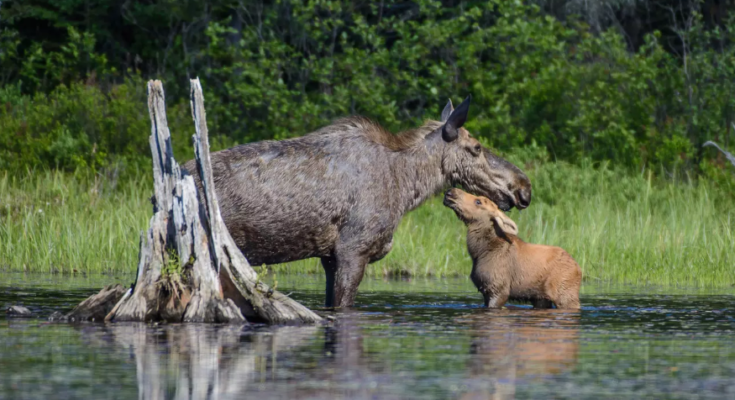1. Moose

The moose (Alces alces) inhabits the northern US and Canada and northern regions of Europe and Asia. Moose are known for their huge antlers, which they shed during the winter and regrow in the spring. These antlers help male moose assert dominance and protect their eyes while competing for a mate. Female moose do not have antlers. Moose are classed as least concern, but they do face human-caused threats to their habitats, including forestry and agriculture.
2. Bison

The largest land animal in North America, the American bison (Bison bison) stands up to 2 meters (6 feet) tall and weighs up to 900 kilograms (2,000 pounds). Although bison are often referred to as buffaloes, they are actually unrelated to true buffaloes, a group of wild cattle native to Asia and Africa. Baby bison are known as ‘red dogs’ due to the red-orange color of their fur.
Before Europeans arrived, millions of bison stretched across the continent from Alaska to Mexico, but as settlers moved westward, their numbers were reduced to just a few hundred. Yellowstone National Park in the US is the only place where they have lived uninterrupted since prehistoric times. Bison have historically been important animals to many Indigenous communities, as they have provided food, clothing, fuel, tools, and shelter, as well as being spiritually significant. As the species is reliant on conservation to survive, it is listed as near threatened.
3. Arctic wolf

Native to the High Arctic region of Canada, Alaska, and Greenland, the Arctic wolf (Canis lupus arctos) is a subspecies of the grey wolf. These wolves have white coats year-round, which provide camouflage in their permanently snow-covered habitats—one of the most remote habitats in the world. Arctic wolves are well adapted to frigid temperatures and can survive through the harsh, almost permanently dark winters, able to live for several weeks without food. They don’t even need to hibernate.
These wolves live far north of the range of most human civilization—they’ve never been hunted or displaced by agriculture or industrialization, which may explain why they’re unafraid of humans. Currently, they are listed as least concern. However, increasing global temperatures and the growing industrialization of the Arctic are likely to pose a threat to Arctic wolves in the near future.
4. Grey whale

The grey whale (Eschrichtius robustus) is a baleen whale native to the east and west coasts of North America as well as Iceland, Japan, and the east coast of the Asian continent. Its population has been depleted to the point that grey whales have disappeared from the North Atlantic, thanks to commercial whaling. These whales now are found only in the Pacific.
Grey whales make an amazing migratory journey, swimming all the way from Laguna San Ignacio, Mexico, where they give birth, to the Bering Sea, which divides Russia from Alaska. In 2000, Mexico and the Mitsubishi corporation were going to construct a salt factory in Laguna San Ignacio, the grey whale’s last undisturbed nursery. Fortunately, IFAW’s campaign against it was able to stop this construction.
Vessel strikes and fishing gear entanglement also threaten the grey whale.
5. Canada lynx

Characterized by its long, dense fur, snowshoe-like paws, and black-tufted ears, the Canada lynx (Lynx canadensis) is native to Canada and the US states of Alaska, Maine, Montana, Washington, Minnesota, Colorado (and possibly Wyoming, Wisconsin, Michigan, and New Hampshire). They live in boreal forests and mainly target snowshoe hares as prey. The Canada lynx’s large feet help it traverse snowy areas. Though they are much larger than house cats, lynx are not considered big cats like tigers and lions. They are about 75 to 90 centimeters (30 to 35 inches) long and weigh 6 to 14 kilograms (15 to 30 pounds). The IUCN classes this species as least concern.



